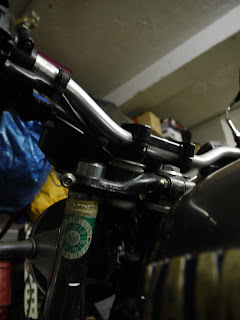Let's start off with the subframe. With all the mounts and clamps in the right places, it was about time to plug the ends. Originally I wanted to turn up some plugs on the lathe, but in the end I decided that it would be quicker and easier to just weld the ends shut.
Next were some touch ups on the frame, where I had to remove a bolt.
For the very first time I tried a paint-system, which was two-pack, but in normal spray cans. Now I am by no means a talented painter of sorts, but the results are pretty impressive. (As are the paint fumes...)
The last thing I wanted to address, was a "little" issue I noticed during my first test-ride: The rubber dampers of the bar mounts were completely shot, as in torn and completely mushy. Therefore I turned them up from some POM-barstock I had lying around, with the result that the steering is now nice and direct. (Probably one of those mods, which would also make sense on a bike without a sidecar!)
 |
| One of those priceless, middle-of-the-night freehand sketches... |
And once run outside of the workshop the bike's sounds quite reasonable and not as obnoxiously loud.























































